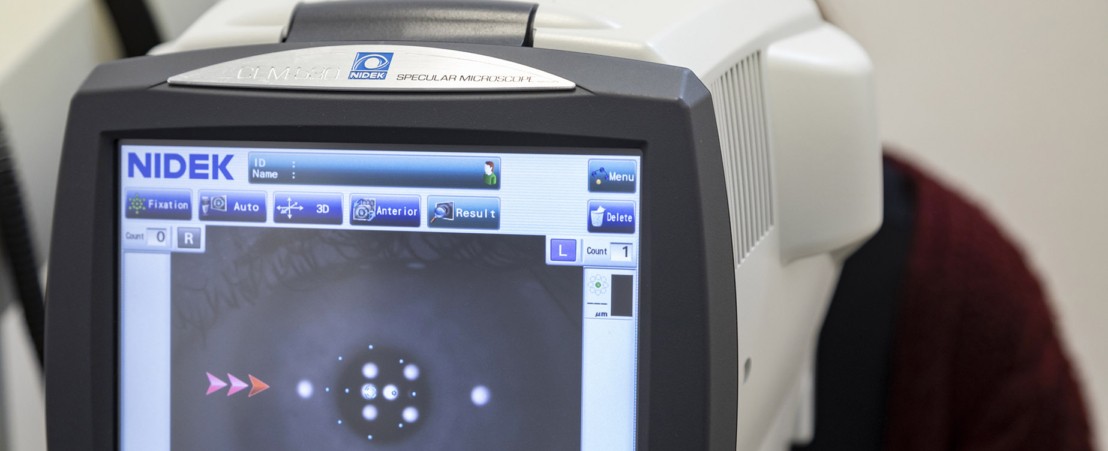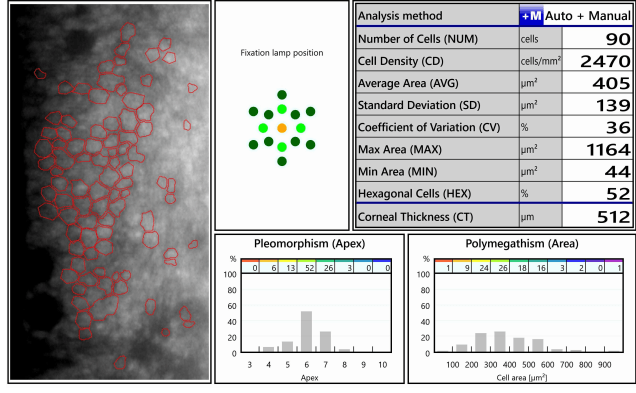
Specular microscopy is an optical test used to study the cornea, the transparent cellular layer that covers the eye, specifically the structure known as the endothelial tissue of the cornea, as well as to determine the number, shape and size of its endothelial cells. By means of the endothelial count, high-resolution images are obtained, so that an analysis of these images can be performed, a morphometric study of the cells can be made and possible lesions in this structure can be detected.
In general, a young healthy person shows in this internal layer a uniform pattern of hexagonal cells with the same size. This pattern can be altered as we grow up, due to pathological causes or surgical procedures. As a consequence of this change, there may be a loss of cells and even in situations of advanced cell loss, a decrease in vision.
Specular microscopy is mainly used for the systematic preoperative examination of patients who want to have cataract surgery or phakic lens implantation surgery. It is also used for the diagnosis and follow-up of corneal degeneration and dystrophies.
The technique does not require any prior preparation, although it is important to perform it without the lenses in order to obtain adequate results.
In case of suspicion of altered results due to the use of contact lenses, it is recommended to repeat the test after 48 hours of rest.
Specular microscopy is a non-invasive technique, so it does not require direct contact with the eye and does not cause adverse reactions. After the test, therefore, any day-to-day activity can be carried out without any problem.
The test is performed using a non-contact specular microscope, which evaluates the cells of the most internal corneal layer, studies their density, size and shape. The microscope used is the CEM-530, the equipment besides characterizing the endothelial layer allows to know the value of the corneal thickness as a pachymeter.
This technique is based on projecting a beam of light at a certain angle on the cornea of the eye. The light is reflected onto the corneal endothelium and is collected again by the instrument, which amplifies the illuminated area and analyzes the cellular pattern, determining the density of cells in the area of capture. Once the data has been collected, the ophthalmologist will be responsible for interpreting the results and transmitting them during the next visit.
The department in charge of performing the test is the Department of Optometry, which performs all the ophthalmological tests necessary for the diagnosis and follow-up of the different ocular pathologies and the entire visual system. The Department has the most advanced diagnostic equipment and the most modern technology, and its more than 50 optometrists are specifically trained to perform these tests.

No, since it is a non-invasive technique, it does not contact the eye, so it does not cause any harm.
No, this test does not require you to be accompanied by another person.
It is not necessary to come fasting for the realization of the test.
The data are obtained at the same time the test is taken. If an ophthalmologist’s report is required, the reported test will be returned within a few days.
The optometrist is the one in charge of performing the test and has the knowledge to confirm its correct performance. The one who has to interpret and report the results obtained is the ophthalmologist, who will do it having the clinical context after a complete anamnesis and examination of the patient.
The normal values in this test are not exact numbers. They cannot be determined by interpreting the test alone. The ophthalmologist interprets them in the context of the patient’s symptomatology and ophthalmological examination.
Yes, after the test it is possible to carry out any day-to-day activity, such as driving or taking a shower.
What Specular Microscopy Reveals About Your Patients. Review of cornea and contact lenses
Specular Microscopy. American Academy of Ophthalmology

Contact us or request an appointment with our medical team.